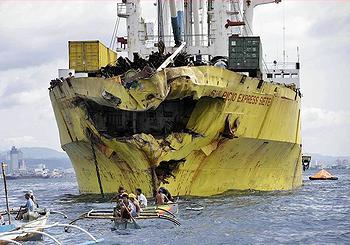
CEBU CITY, Philippines, August 23, 2013 (ENS) – Oil from the collision of two vessels off the coast of Cebu Province that killed dozens of people last Friday is still spreading to nearby shorelines as government workers and local residents struggle to contain it.

The Philippine Coast Guard says the 2Go Shipping Lines ferry, MV St. Thomas Aquinas 1, which sank August 16 after colliding with the freighter Sulpicio Express 7, was carrying 120,000 liters of bunker oil, 20,000 liters of lube oil and 20,000 liters of diesel oil. An unknown amount of these petroleum products has spilled into the sea.
The ferry sank in waters off the coast of Talisay City, an environmentally sustainable city that celebrates Earth Day. The coast of Cebu is known for its pristine waters and spectacular coral reefs that attract dive tourists from around the world.
Chemical dispersants are being used to break up the spill, and containment and absorbent booms have been deployed, but the oil was spread by the torrential rains of a southwest monsoon worsened by Tropical Storm Maring.
Navy spokesman Lt. Cmdr. Gregory Fabic said oil spill clearing operations off the coast started Thursday morning.
The National Disaster Risk Reduction and Management Council says the oil spill has so far affected 26 villages, in the town of Cordova on Mactan island, where five-star resorts line the shore.

The council’s executive director, Eduardo del Rosario, said residents and local disaster personnel have been collecting local materials such as coconut husks, sawdust, chicken feathers and hair to help clean up the oil.
“The Cebu City DRRMC spearheaded mass haircut at Plaza Sugbu. The provincial government and Cebu City local government requested donations of indigenous materials for the containment of the oil spill,” said Del Rosario.
Even the world-famous Cebu Dancing Inmates are donating their hair to help absorb the oil. The 1,600 inmates of the Cebu Provincial Detention and Rehabilitation Center are getting their hair cut to fill an oil spill boom. They hope it will absorb some of the oil and prevent it from spreading further in the waters of Cordova.
Meanwhile, Cordova Mayor Adelino Sitoy is working with national authorities on toxic and hazardous wastes disposal. Treatment and storage disposal operator, Andrew Co, has provided Cordova with empty barrels for the collection of spilled oil.
The oil also has blackened some aquaculture areas. “There were fish cages and seaweed farms that have been affected by the oil spill as well as mangrove areas where shellfish are raised,” said Asis Perez, director of Bureau of Fisheries and Aquatic Resources today after inspecting the spill area.
The agency estimates that 1,750 fisherfolk in 13 coastal villages have been affected by the spill.
The St. Thomas Aquinas ferry was carrying more than 800 passengers and crew when the collision occurred off the city of Talisay in Cebu Province. To date, the death toll stands at 76, with 44 others still missing.

Lieutenant Commander Noel Escalona, operations officer of Naval Forces-Central, said 35 of the bodies were recovered from the sunken ferry by specialized technical divers. Escalona said oil leaking from the sunken ferry, strong water currents, strong winds and wave on the sea surface and floating debris inside the ship have hampered their work.
The Province of Cebu declared a state of calamity on Monday.
Today, the Philippines Coast Guard’s Special Board of Marine Inquiry began investigating the incident at the headquarters of the Coast Guard District Central Visayas in Cebu City.
The Department of Environment and Natural Resources, through its Environmental Management Bureau, also will conduct a field investigation to determine the extent of damage caused by the spill and collect water samples for further laboratory tests, according to DENR-7 Information Officer Dr. Eddie Llamedo.
The DENR team will assist the investigation led by the Philippine Coast Guard.
The captain of the St. Thomas of Aquinas submitted himself for an initial investigation by the Special Board of Marine Inquiry today at the Headquarters of the Coast Guard District Central Visayas in Cebu City.
Capt. Reynan Bermejo told the investigators that many attempts to communicate with the Sulpicio Express 7 at Channel 16, the official radio public frequency used by ships to communicate, were unanswered. Bermejo said only radar contact was made with the approaching cargo vessel.
Bermejo said he was inbound, while the Sulpicio Express 7 was outbound with a point of collision on the inbound lane of the traffic separation scheme.
He said his vessel was trapped between shallow waters and the outbound cargo vessel, which had moved into the inbound lane.
The 2Go company said the St. Thomas Aquinas was carrying mostly agricultural products from Mindanao since the vessel came from Surigao and Nasipit port. There were no cargoes marked as Dangerous Goods.
The Philippine Span Asia Carrier Corp., formerly Sulpicio Lines, said it is conducting its own probe of the incident. But the company also said it will not be issuing more statements to the press until the official government investigation is concluded, and the findings are released to the public.
This is the second major oil spill in Philippine waters in the past two weeks. A massive diesel spill August 9 from an underwater pipe owned by the Philippines’ largest oil company, Petron Corporation, fouled the waters of Manila Bay.
Copyright Environment News Service (ENS) 2013. All rights reserved.
© 2013, Environment News Service. All rights reserved. Content may be quoted only with proper attribution and a direct link to the original article. Full reproduction is prohibited.
